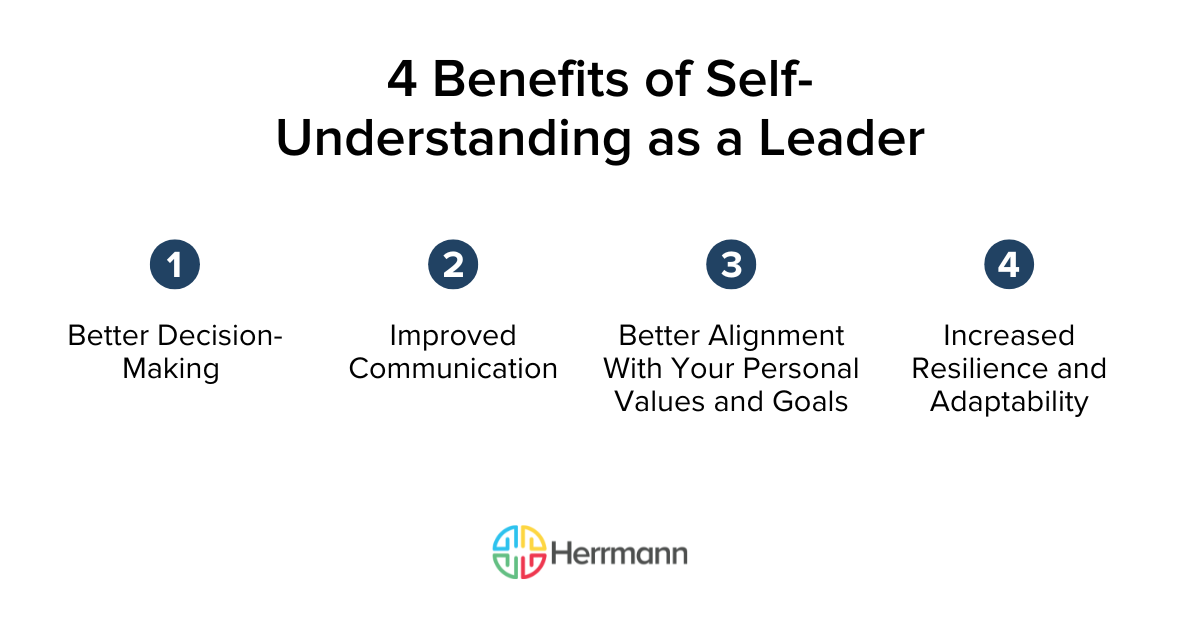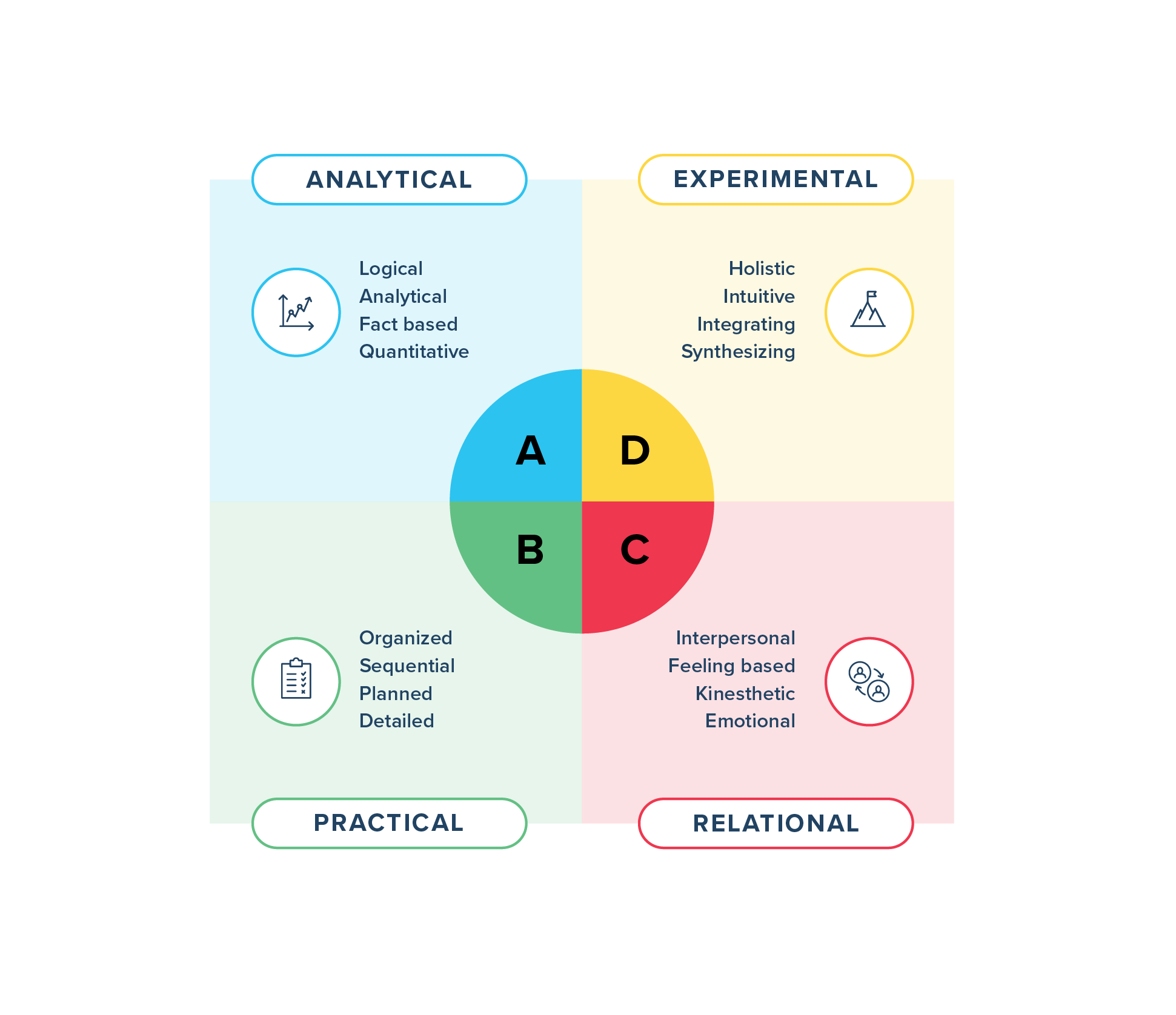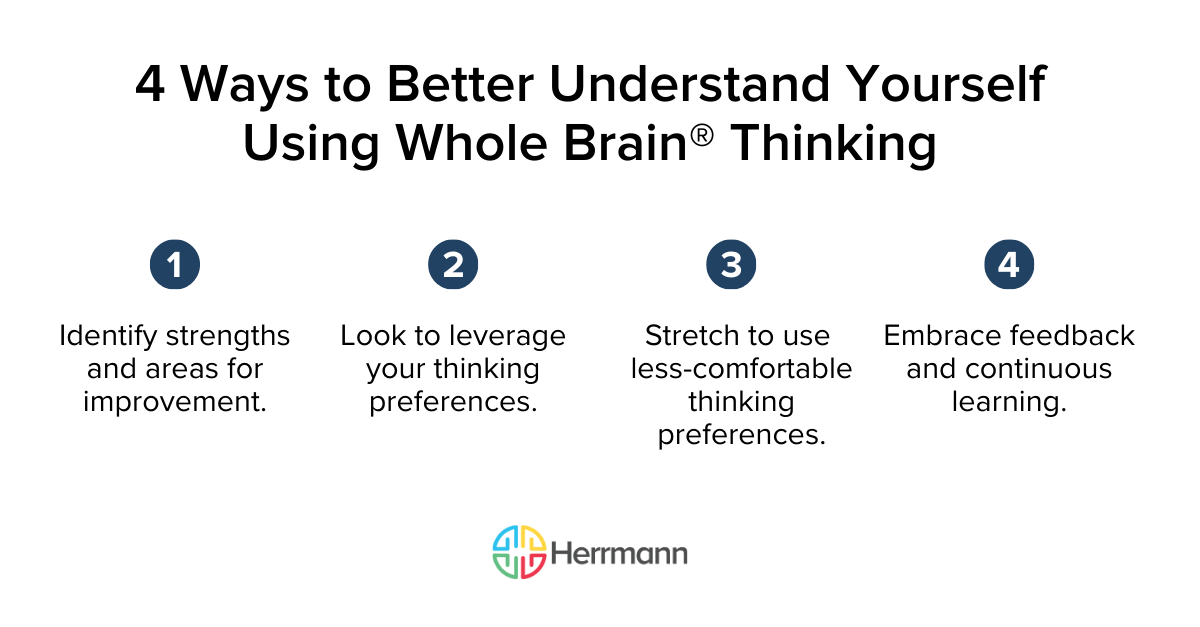What does it mean to be our best selves as a leader?
One way to define this is when we act in alignment with our values and with awareness of our thinking, our strengths and weaknesses, and the environment around us. Chasing that ideal begins with knowing how to understand yourself better.
Within workplace teams, Gallup finds that employees who understand their strengths usually have the best outcomes within workplace teams. Other research suggests that strong self-awareness improves creativity, decision-making, and relationship-building, among other benefits.
Another way to consider self-understanding’s benefits is through our Whole Brain® Thinking Model. This framework helps individuals, teams, and organizations better understand how they think and how to leverage different thinking styles to improve communication, thinking, and business outcomes.
Self-understanding isn’t just about you, however. Understanding how your co-workers and customers think is imperative as business becomes more complex. Self-understanding helps you understand your thinking and impact on others and gives you the foundation to better interpret other people’s thoughts, words, and actions.
Learn more about the concept of self-understanding, how you can improve your self-awareness at work, and how Whole Brain® Thinking can help.

Why Is It Important to Understand Yourself as a Leader?
Before explaining why self-understanding matters, we need to define the term. As researchers studying self-awareness have found, we need precise definitions to develop theories for teaching these terms.
Self-understanding in this context means being a leader who's aware of yourself and your surroundings — and of the factors that go into creating those conditions. When you’re aware and cognizant, you can confidently develop your thinking, strengths, interactions with others, and ability to understand others’ thinking and actions.
Here are some of the benefits of self-awareness in leadership.
Better Decision-Making
Self-aware leaders have a deep understanding of their strengths and weaknesses. They can make more informed and thoughtful decisions because they recognize their biases and emotions, such as when leading during a crisis. They're confident in their expertise but humble enough to recognize when a decision requires additional knowledge or information.
Rather than deny their thinking preferences and unconscious biases, they acknowledge them and account for their influence over their choices. As leaders, they won’t be perfect in their decisions, but they’ll strive to make choices that align with long-term team and organizational goals.
Improved Communication
Self-aware leaders understand their preferred communication styles and how others may perceive them. This awareness enables them to adapt their approach to different individuals and situations, helping reduce and solve communication issues in the workplace.
By recognizing their communication strengths and areas for improvement, leaders can respond well to a variety of challenging situations and personalities, leading to more impactful interactions with their teams and other stakeholders.
Better Alignment With Your Personal Values and Goals
When you understand yourself as a leader, you can clearly state your values and beliefs — and deliberately strive to convert them into behaviors. This awareness allows for leading with authenticity and integrity. This alignment brings a sense of purpose and fulfillment to leadership — and if you’re off-course, trusted colleagues can recognize this and help you course-correct.
For decisions with ethical or moral implications, these self-understanding leaders draw a straight line from their values to their decision-making processes. They’re less likely to be frozen by indecision or flip-flop based on the prevailing winds.
Increased Resilience and Adaptability
Leaders who lack awareness or feel insecure in their identity will struggle to be resilient and adaptable in the face of challenges and change. Even minor setbacks will trigger worry and insecurity, demanding an immediate response rather than the most advisable course of action.
By contrast, understanding your values, thinking, and emotions enables leaders to recognize those triggers and manage their emotions effectively, even in high-pressure situations. Additionally, self-aware leaders are open to continuous learning, which enhances their ability to adapt to new circumstances.

What Are Whole Brain® Thinking and the HBDI®?
The Whole Brain® Model is a metaphor for how we think, imagining that every person has access to our Whole Brain® and is regularly activating many different areas simultaneously. Over time, we develop distinct thinking preferences, which can be grouped into four quadrants: analytical, practical, relational, and experimental.
Each quadrant is equal to the others, and we’re not limited to just one. In fact, many of us have strong preferences for multiple quadrants. Indeed, Whole Brain® Thinking recognizes that individuals have aptitude and potential in each quadrant. We can unlock and use all four quadrants in thinking and decision-making.
Whole Brain® Quadrants
- Analytical (Blue): Analytical thinking is characterized by logical and methodical processing. Such individuals gravitate toward facts, data, and evidence. They often take an analytical and quantitative approach.
- Practical Thinking (Green): Practical thinking focuses on applying knowledge to real-world situations. These individuals are skilled at organizing, planning, and taking action. They look to manage resources, be efficient, and embrace the details.
- Relational Thinking (Red): Relational thinking emphasizes interpersonal interactions and relationship-building. Individuals with this preference excel at communication, collaboration, and fostering connections with others. They're empathetic and intuitive.
- Experimental Thinking (Yellow): Experimental thinking is characterized by creativity, innovation, and a willingness to explore new ideas and possibilities. Individuals with this preference enjoy conceptual thinking. They thrive in environments that encourage brainstorming, ideation, and pushing boundaries.
HBDI®
The Herrmann Brain Dominance Instrument® (HBDI®) is an assessment tool that measures an individual's thinking preferences across the four quadrants of the Whole Brain® Model. The HBDI® provides individuals with a profile of their thinking preferences, indicating the degree of preference in each quadrant.
If you’re a leader looking to understand yourself better and be more effective at work, this type of assessment can help. The HBDI® can be the first step to deciphering your thinking preferences and their influence on problem-solving, decision-making, communication, and collaboration.
Understanding the implications of your thinking preferences can be transformative. You’ll have a better sense of your strengths and areas for development. You'll be more likely to make conscious choices in approaching tasks and challenges. And you’ll be better prepared to adapt your thinking style to different situations — and help your team do the same.

Applying Whole Brain® Thinking to Understand Yourself Better in the Workplace
How does self-awareness help you become a better leader? Once you understand your thinking preferences and how they affect others, you can apply this knowledge to your workplace words and deeds. Here are some ways you can continue building self-understanding with Whole Brain® Thinking.
Identify Strengths and Areas for Improvement
Whole Brain® Thinking provides a framework for understanding your thinking preferences and identifying your strengths and areas for improvement. By reflecting on your HBDI® profile and understanding the implications of your thinking preferences, you can gain valuable insights into your natural talents and abilities.
Here’s a simple example: You’re a leader with a strong preference for analytical thinking (Blue) and a secondary preference for practical thinking (Green). You gravitate toward analyzing data, conducting research, making logical decisions, and executing detailed, organized plans. Your team appreciates how you can break down complex problems and provide clear direction.
However, this strong preference for analytical thinking sometimes leads you to overanalyze situations or get bogged down in details. Your communication style may lean toward logical and data-driven explanations, failing to convey your connection to and care for your employees (Red). Similarly, once you’ve made up your mind, it’s hard for anyone to propose alternatives. This can make it challenging for employees with strong relational (Red) or experimental (Yellow) preferences to feel heard or seen. Sometimes, these employees might not understand why you reached your conclusions, only that they feel left out of the process.
Look to Leverage Your Thinking Preferences
Recognize which tasks and projects match your preferred thinking style or styles. By aligning your work with your thinking preferences, you can maximize your productivity and contribute in a natural and fulfilling way.
Suppose you’re a team leader with a strong preference for relational thinking. You can embrace this preference by actively listening to your team members, seeking to understand their needs and pain points, and providing guidance and support.
Consider how your preference for relational thinking can help your less Red-oriented employees. For example, team-building activities can be a low-pressure way to help your employees get to know each other better in a safe environment while promoting a sense of unity.
Stretch to Use Less-Comfortable Thinking Preferences
While your preferred modes of thinking are likely strengths, it's also valuable to stretch and use your less-preferred thinking preferences, especially in challenging or novel situations where a new perspective is needed.
Challenge yourself to step outside your comfort zone and engage in tasks requiring different thinking preferences. For example, perhaps you’re over-relying on practical thinking to the point of trying to force organization and sequence into chaotic situations. Consider intentionally seeking opportunities that are more experimental or relational. Look for ways to engage creatively with peers, even if it’s relatively low stakes (joining an internal event-planning committee, for example).
With your team, you might encourage practical (Green) thinkers to stretch with a collaborative brainstorming meeting. Make sure team members understand that the point isn't to deliver fully formed ideas but to think widely, share openly, and iterate on the best ideas.
These stretching exercises help you and your team become more well-rounded in your thinking — and more adaptable in challenging situations.
Embrace Feedback and Continuous Learning
To deepen your understanding of your thinking preferences and their implications, seek feedback from others. This could be in discussions about HBDI® profiles, 360 reviews, or conversations with mentors or coaches, among other settings. Embrace a mindset of continuous learning about your work and who you are as a person. Explore resources or training that can help you further develop your thinking preferences and expand your capabilities.
As a manager or executive, have regular one-on-one meetings with your reports that include space for their feedback on the work itself or what they need from you. Take this feedback seriously. Use it as an opportunity for self-reflection and growth.
Use Whole Brain® Thinking to Understand Yourself as a Leader
Leaders need self-awareness to be effective at work. Without it, your team will quickly realize the disconnect between your stated values and what you say and do. You’ll likely struggle to connect with colleagues or to communicate well.
Fortunately, you can practice self-awareness. Learn how to understand yourself better through self-reflection, feedback, practice, and tools like Whole Brain® Thinking. When you understand yourself, you can better understand — and support — your team.
Looking to learn more about the HBDI® and how it can help your team? Find out more about this validated assessment that's designed for business use in our guide comparing the HBDI® and other assessments.












